Discover 35 hidden attractions, cool sights, and unusual things to do in Philadelphia (United States). Don't miss out on these must-see attractions: Independence Hall, Philadelphia Museum of Art, and Barnes Foundation. Also, be sure to include Please Touch Museum in your itinerary.
Below, you can find the list of the most amazing places you should visit in Philadelphia (Pennsylvania).
Table of Contents
Independence Hall
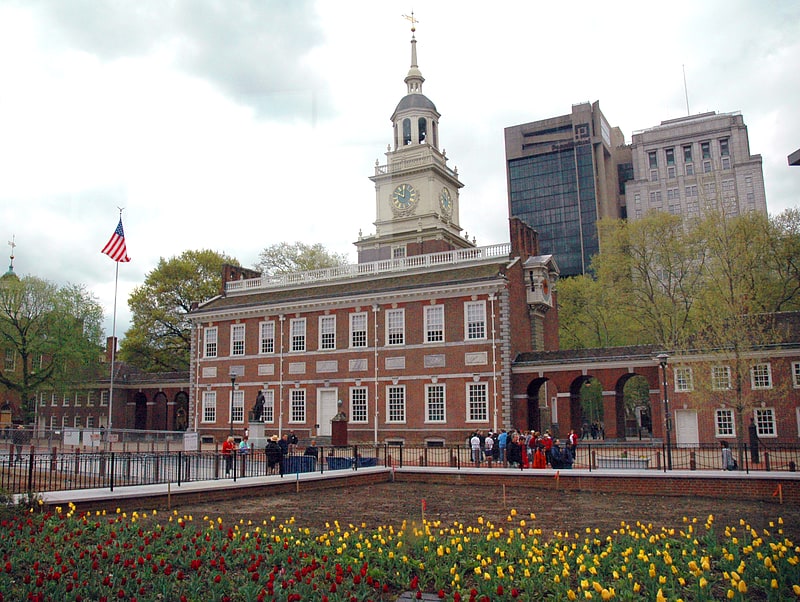
Building in Philadelphia, Pennsylvania. Independence Hall is a historic civic building in Philadelphia, Pennsylvania in which both the United States Declaration of Independence and the United States Constitution were debated and adopted by America's Founding Fathers. The structure forms the centerpiece of the Independence National Historical Park and has been designated a UNESCO World Heritage Site.
The building was completed in 1753 as the Pennsylvania State House, and served as the capitol for the Province and Commonwealth of Pennsylvania until the state capital moved to Lancaster in 1799. It became the principal meeting place of the Second Continental Congress from 1775 to 1783 and was the site of the Constitutional Convention in the summer of 1787.
A convention held in Independence Hall in 1915, presided over by former US president William Howard Taft, marked the formal announcement of the formation of the League to Enforce Peace, which led to the League of Nations and eventually the United Nations.[1]
Address: 520 Chestnut St, 19106 Philadelphia (Center City)
Philadelphia Museum of Art
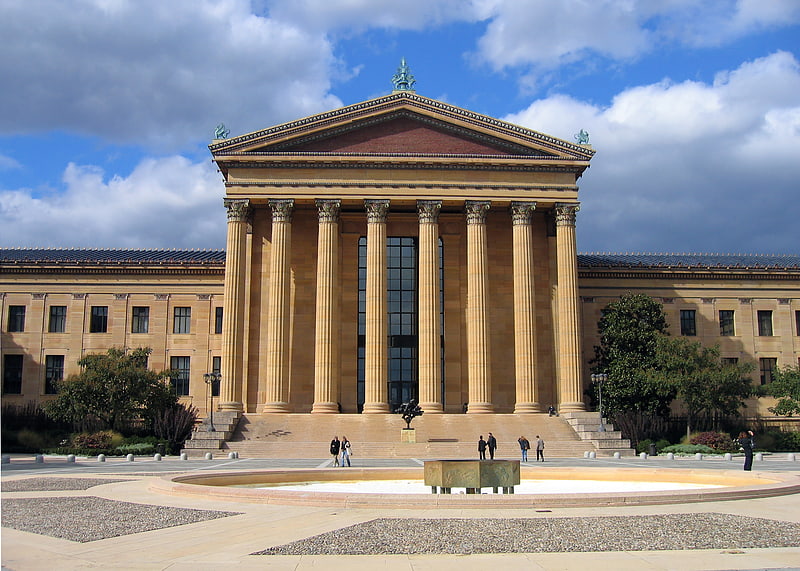
Famed art museum with classic pieces. The Philadelphia Museum of Art is an art museum originally chartered in 1876 for the Centennial Exposition in Philadelphia. The main museum building was completed in 1928 on Fairmount, a hill located at the northwest end of the Benjamin Franklin Parkway at Eakins Oval. The museum administers collections containing over 240,000 objects including major holdings of European, American and Asian origin. The various classes of artwork include sculpture, paintings, prints, drawings, photographs, armor, and decorative arts.
The Philadelphia Museum of Art administers several annexes including the Rodin Museum, also located on the Benjamin Franklin Parkway, and the Ruth and Raymond G. Perelman Building, which is located across the street just north of the main building. The Perelman Building, which opened in 2007, houses more than 150,000 prints, drawings and photographs, along with 30,000 costume and textile pieces, and over 1,000 modern and contemporary design objects including furniture, ceramics and glasswork. The museum also administers the historic colonial-era houses of Mount Pleasant and Cedar Grove, both located in Fairmount Park. The main museum building and its annexes are owned by the City of Philadelphia and administered by a registered nonprofit corporation.
Several special exhibitions are held in the museum every year, including touring exhibitions arranged with other museums in the United States and abroad. The museum had 437,348 visitors in 2021, ranking 65th on the List of most-visited art museums worldwide.[2]
Address: 2600 Benjamin Franklin Pkwy, 19130 Philadelphia (Lower North)
Barnes Foundation
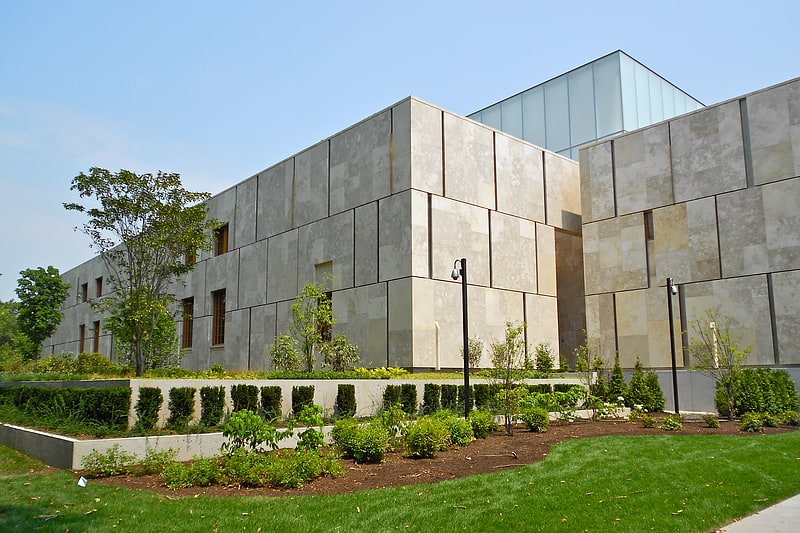
World-class art exhibits. The Barnes Foundation is an art collection and educational institution promoting the appreciation of art and horticulture. Originally in Merion, the art collection moved in 2012 to a new building on Benjamin Franklin Parkway in Philadelphia, Pennsylvania. The arboretum of the Barnes Foundation remains in Merion, where it has been proposed to be maintained under a long-term educational affiliation agreement with Saint Joseph's University.
The Barnes was founded in 1922 by Albert C. Barnes, who made his fortune by co-developing Argyrol, an antiseptic silver compound that was used to combat gonorrhea and inflammations of the eye, ear, nose, and throat. He sold his business, the A.C. Barnes Company, just months before the stock market crash of 1929.
Today, the foundation owns more than 4,000 objects, including over 900 paintings, estimated to be worth about $25 billion. These are primarily works by Impressionist, Post-Impressionist, and Modernist masters, but the collection also includes many other paintings by leading European and American artists, as well as African art, antiquities from China, Egypt, and Greece, and Native American art.
In the 1990s, the Foundation's declining finances led its leaders to various controversial moves, including sending artworks on a world tour and proposing to move the collection to Philadelphia. After numerous court challenges, the new Barnes building opened on Benjamin Franklin Parkway on May 19, 2012. The foundation's current president and executive director, Thomas “Thom” Collins, was appointed on January 7, 2015.[3]
Address: 2025 Benjamin Franklin Pkwy, 19130 Philadelphia (Center City)
Please Touch Museum
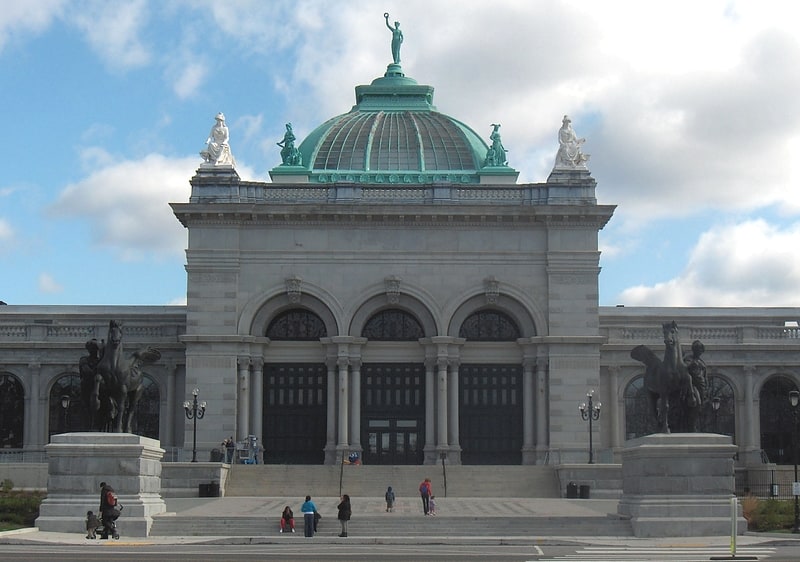
Museum in Philadelphia, Pennsylvania. The Please Touch Museum is a children's museum located in the Centennial District of Philadelphia, Pennsylvania, USA. The museum focuses on teaching children through interactive exhibits and special events, mostly aimed at children seven years old and younger.[4]
Address: 4231 Avenue of the Republic, 19131-3719 Philadelphia (West Philadelphia)
Mütter Museum
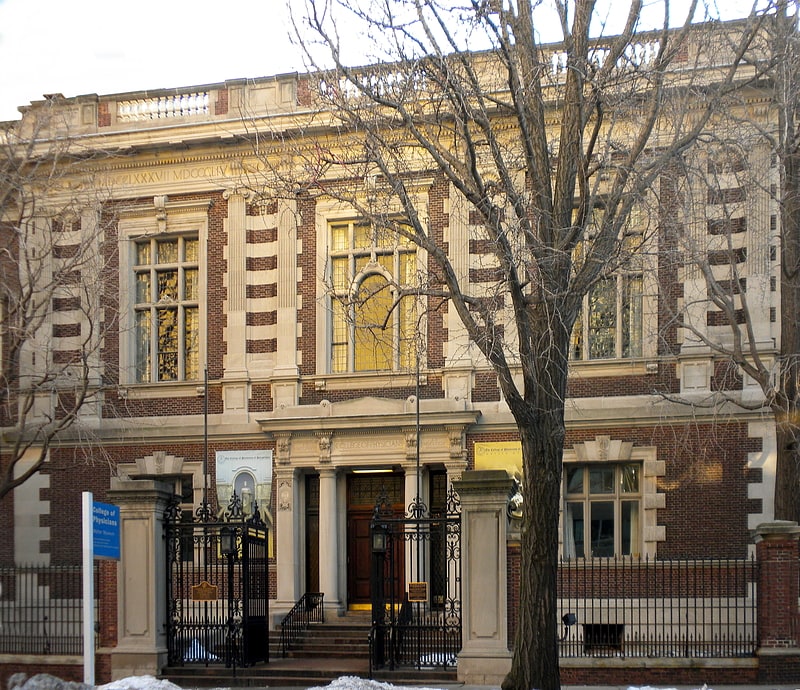
Medical history and pathology on display. The Mütter Museum is a medical museum located in the Center City area of Philadelphia, Pennsylvania. It contains a collection of anatomical and pathological specimens, wax models, and antique medical equipment. The museum is part of The College of Physicians of Philadelphia. The original purpose of the collection, donated by Dr. Thomas Dent Mutter in 1858, was for biomedical research and education.[5]
Address: 19 S 22nd St, 19103 Philadelphia (Center City)
National Constitution Center

History museum in Philadelphia. The National Constitution Center is a non-profit institution devoted to the Constitution of the United States. On Independence Mall in Philadelphia, Pennsylvania, the center is an interactive museum and a national town hall for constitutional dialogue, hosting government leaders, journalists, scholars, and celebrities for public discussions. The center offers civic learning resources onsite and online. It does not house the original Constitution, which is stored at the National Archives Building in Washington, D.C.
The groundbreaking ceremony (attended by President Bill Clinton) was held on September 17, 2000, the 213th anniversary of the signing of the Constitution. The center opened on July 4, 2003, joining other historic sites and attractions in what has been called "America's most historic square mile" because of its proximity to Independence Hall and the Liberty Bell.[6]
Address: 525 Arch St, 19106 Philadelphia (Center City)
Liberty Bell
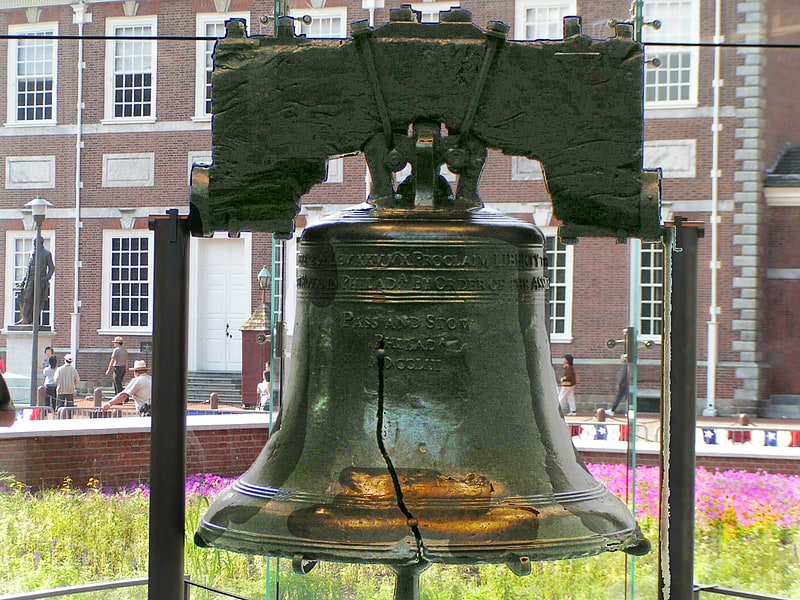
Historic symbol of American freedom. The Liberty Bell, previously called the State House Bell or Old State House Bell, is an iconic symbol of American independence, located in Philadelphia, Pennsylvania. Once placed in the steeple of the Pennsylvania State House, the bell today is located across the street in the Liberty Bell Center in Independence National Historical Park. The bell was commissioned in 1751 by the Pennsylvania Provincial Assembly from the London firm of Lester and Pack, and was cast with the lettering "Proclaim LIBERTY Throughout all the Land unto all the Inhabitants Thereof", a Biblical reference from the Book of Leviticus. The bell first cracked when rung after its arrival in Philadelphia, and was twice recast by local workmen John Pass and John Stow, whose last names appear on the bell. In its early years, the bell was used to summon lawmakers to legislative sessions and to alert citizens about public meetings and proclamations.
Although no immediate announcement was made of the Second Continental Congress's vote for independence—and so the bell could not have rung on July 4, 1776, related to that vote—bells were rung on July 8 to mark the reading of the United States Declaration of Independence. While there is no contemporary account of the Liberty Bell ringing, most historians believe it was one of the bells rung. After American independence was secured, the bell fell into relative obscurity until, in the 1830s, the bell was adopted as a symbol by abolitionist societies, who dubbed it the "Liberty Bell".
The bell acquired its distinctive large crack some time in the early 19th century—a widespread story claims it cracked while ringing after the death of Chief Justice John Marshall in 1835. The bell became famous after an 1847 short story claimed that an aged bellringer rang it on July 4, 1776, upon hearing of the Second Continental Congress's vote for independence. Although the bell did not ring for independence on that July 4, the tale was widely accepted as fact, even by some historians. Beginning in 1885, the city of Philadelphia—which owns the bell—allowed it to go to various expositions and patriotic gatherings. The bell attracted huge crowds wherever it went, additional cracking occurred, and pieces were chipped away by souvenir hunters. The last such journey occurred in 1915, after which the city refused further requests.
After World War II, Philadelphia allowed the National Park Service to take custody of the bell, while retaining ownership. The bell was used as a symbol of freedom during the Cold War and was a popular site for protests in the 1960s. It was moved from its longtime home in Independence Hall to a nearby glass pavilion on Independence Mall in 1976, and then to the larger Liberty Bell Center adjacent to the pavilion in 2003. The bell has been featured on coins and stamps, and its name and image have been widely used by corporations.[7]
Address: 21 S 5th St, 19106-2521 Philadelphia (Center City)
Walnut Street

Street in Philadelphia, Pennsylvania. Walnut Street is located in downtown Philadelphia and extends from the city's Delaware River waterfront through Center City and West Philadelphia. Walnut Street has been characterized as "the city's premier shopping district". A portion of the street commonly called Rittenhouse Row was ranked 12th in 2005 by Women's Wear Daily among its list of the most expensive retail streets in North America, with rents of $90 per square foot, and is home to several "upscale dining, retail and cultural" establishments. In 2013 rents had risen to an average of $107 a foot, a growth of 34% over 2012 and the largest percentage growth of any retail corridor in the country.
Running parallel to Walnut Street, one or two blocks to the north (depending on whether the side street Sansom Street is counted), is Chestnut Street. Pennsylvania Route 3 westbound follows Walnut Street from 38th Street (U.S. Route 13) to its western terminus at the Cobbs Creek Parkway.[8]
Address: Walnut St, Philadelphia (West Philadelphia)
Independence Seaport Museum
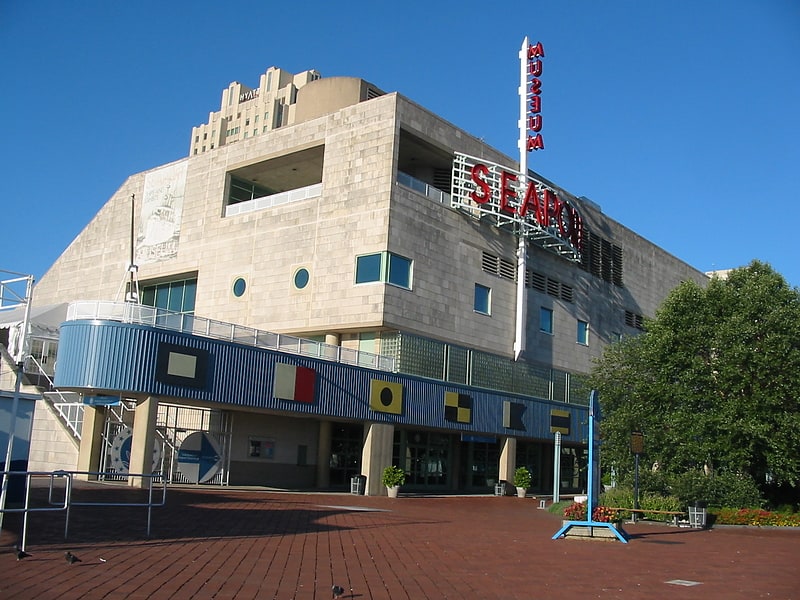
Museum in Philadelphia, Pennsylvania. The Independence Seaport Museum was founded in 1961 and is located in the Penn's Landing complex along the Delaware River in Philadelphia, Pennsylvania. The collections at the Independence Seaport Museum document maritime history and culture along the Delaware River. At the museum are two National Historic Landmark ships and the J. Welles Henderson Archives and Library.[9]
Address: 211 S Christopher Columbus Blvd, 19106-3199 Philadelphia (Center City)
National Museum of American Jewish History
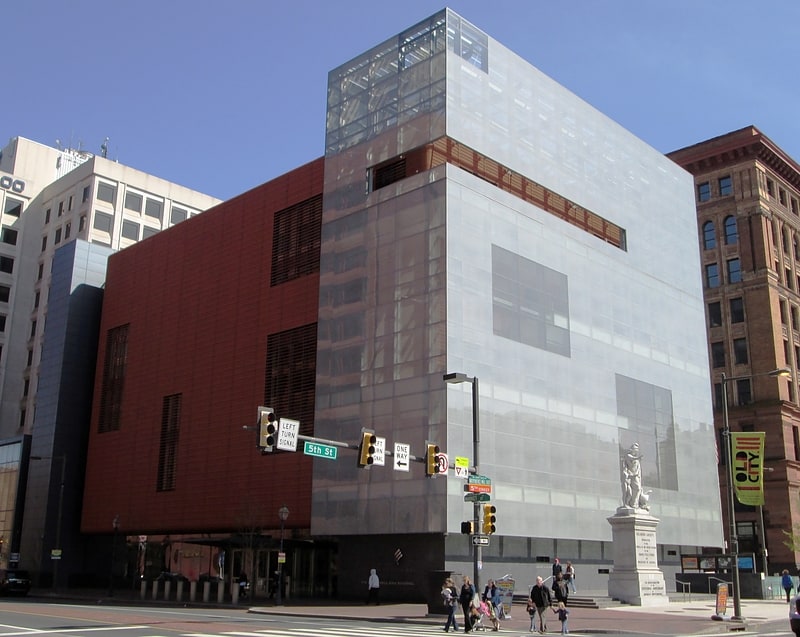
Museum in Philadelphia, Pennsylvania. The National Museum of American Jewish History is a Smithsonian-affiliated museum at 101 South Independence Mall East at Market Street in Center City Philadelphia. It was founded in 1976.
In March 2020, The National Museum of American Jewish History filed for Chapter 11 bankruptcy protection, seeking relief from debt incurred by the construction of its Independence Mall home. The museum's debts included over $30 million to bondholders, and an additional $500,000 to unsecured creditors; at the time of the bankruptcy filing, the museum was paying 20% of its annual budget in interest payments. The filing followed several years of decreasing attendance, revenue, and fundraising. The museum's operations were not affected by the bankruptcy. The museum exited bankruptcy in September 2021.[10]
Address: 101 S Independence Mall E, 19106 Philadelphia (Center City)
Fairmount Park
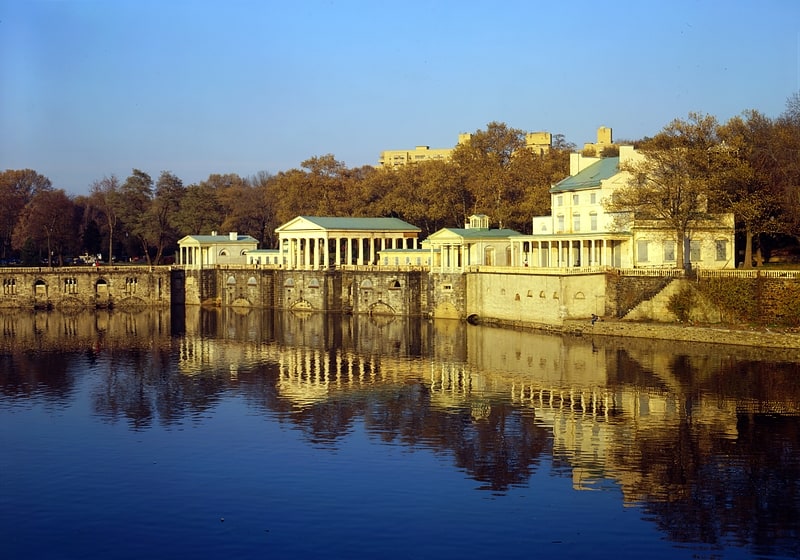
Park in Philadelphia, Pennsylvania. Fairmount Park is the largest municipal park in Philadelphia, Pennsylvania, and the historic name for a group of parks located throughout the city. Fairmount Park consists of two park sections named East Park and West Park, divided by the Schuylkill River, with the two sections together totalling 2,052 acres. Management of Fairmount Park and the entire citywide park system is overseen by Philadelphia Parks & Recreation, a city department created in 2010 from the merger of the Fairmount Park Commission and the Department of Recreation.
Many other city parks had also been historically included in the Fairmount Park system prior to 2010, including Wissahickon Valley Park in Northwest Philadelphia, Pennypack Park in Northeast Philadelphia, Cobbs Creek Park in West Philadelphia, Franklin Delano Roosevelt Park in South Philadelphia and 58 additional parks, parkways, plazas, squares and public golf courses spread throughout the city. Since the 2010 merger, however, the term "Fairmount Park system" is no longer used by the Parks & Recreation department, and the adjacent Wissahickon Valley Park and all other park areas are considered completely separate entities.[11]
Philadelphia Zoo
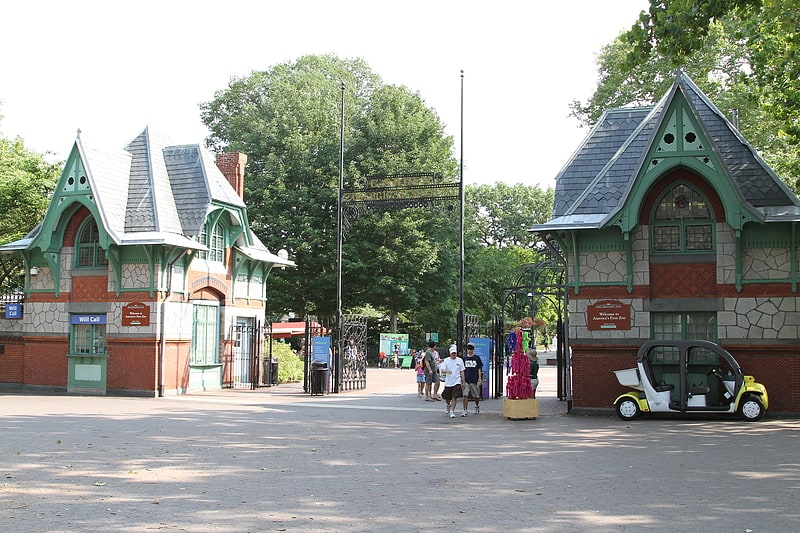
Zoo in Philadelphia, Pennsylvania. The Philadelphia Zoo, located in the Centennial District of Philadelphia, on the west bank of the Schuylkill River, was the first true zoo in the United States. It was chartered by the Commonwealth of Pennsylvania on March 21, 1859, but its opening was delayed by the Civil War until July 1, 1874. The zoo opened with 1,000 animals and an admission price of 25 cents. For a brief time, the zoo also housed animals brought over from safari on behalf of the Smithsonian Institution, which had not yet built the National Zoo.
The Philadelphia Zoo is one of the premier zoos in the world for breeding animals that are difficult to breed in captivity. The zoo also works with many groups around the world to protect the natural habitats of the animals in their care.
The zoo is 42 acres (17 ha) and the home of nearly 1,300 animals, many of which are rare and endangered. Special features include a children's petting zoo, a paddleboat lake, a rainforest themed carousel, a ropes course, and many interactive and educational exhibits.[12]
Address: 3400 W Girard Ave, 19104 Philadelphia (West Philadelphia)
Reading Terminal Market
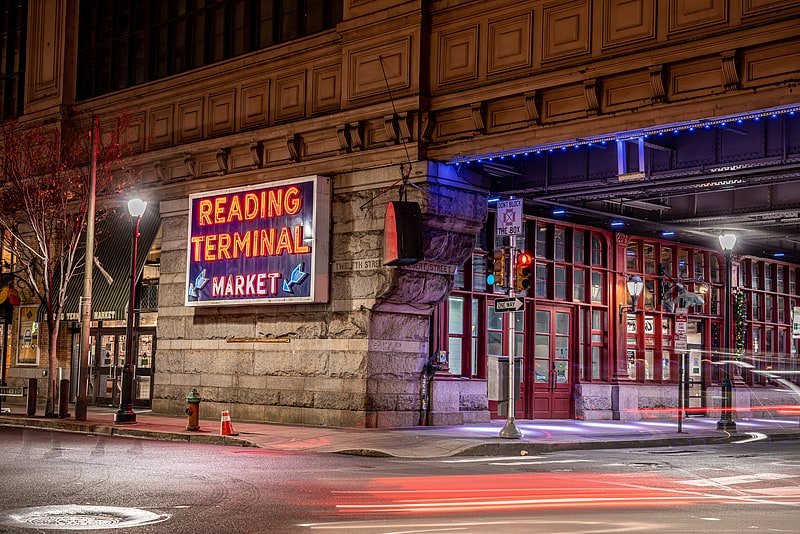
Farmers' market in Philadelphia, Pennsylvania. Reading Terminal Market is an enclosed public market located at 12th and Arch Streets in Center City Philadelphia, Pennsylvania. It opened originally in 1893 under the elevated train shed of the Reading Railroad Company after the city of Philadelphia advocated to move public markets from the streets into indoor facilities for both safety and sanitary reasons. When the Center City Commuter Connection was completed in 1984, the Reading Terminal ceased operating as a train station, impacting foot traffic at the Market. The Reading Company then proposed using the Reading Terminal complex as the site for a new convention center. The site was chosen for the convention center, and in 1990 the Company transferred title to the complex to the Pennsylvania Convention Center Authority. Presently, the Market still occupies the ground floor and basement levels of the Reading Terminal's former train shed which is now part of the Pennsylvania Convention Center. Vendor stalls occupy the ground floor with entrances on Filbert Street to the South, Twelfth Street to the West, and Arch Street to the North. The stalls are arranged in a grid pattern with an open area in the center with tables and seating. Over one hundred merchants offer fresh produce, meats, fish, artisan cheese, groceries, ice cream, flowers, grilled cheese, baked goods, crafts, books, clothing, and specialty and ethnic foods. Two of the vendors are descendants of original merchants from the initial opening in the late 1800s. The basement floor of the market holds the refrigerated storage area for vender use. The storage area was considered state-of-the-art when it was built, in 1893. Currently, the market is open every day of the week, although the Pennsylvania Dutch merchants generally do not operate Sunday through Tuesday.[13]
Address: 51 N 12th St, 19107 Philadelphia (Center City)
Fairmount Water Works
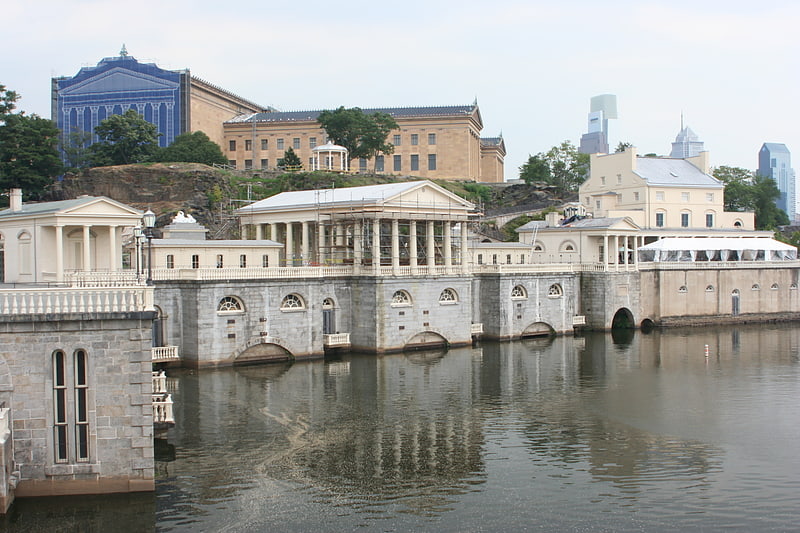
Historical landmark in Philadelphia, Pennsylvania. The Fairmount Water Works in Philadelphia, Pennsylvania was Philadelphia's second municipal waterworks. Designed in 1812 by Frederick Graff and built between 1812 and 1872, it operated until 1909, winning praise for its design and becoming a popular tourist attraction. It now houses a restaurant and an interpretive center that explains the waterworks' purpose and local watershed history. It was designated a National Historic Landmark in 1976 for its architecture and its engineering innovations. It was the nation's first water supply to use paddle wheels to move water.[14]
Address: 640 Waterworks Dr, 19130 Philadelphia (Lower North)
Rodin Museum
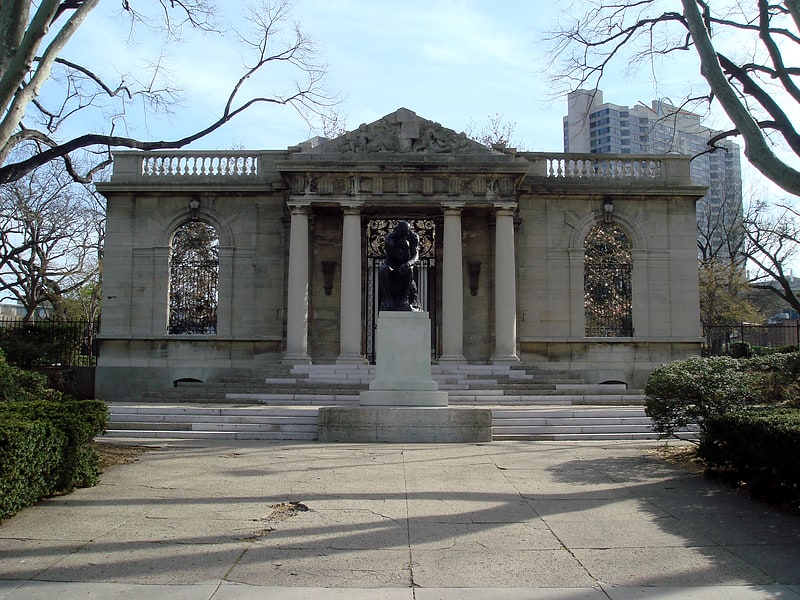
Famous sculptures by French artist. The Rodin Museum is an art museum located in Philadelphia, Pennsylvania that contains one of the largest collections of sculptor Auguste Rodin's works outside Paris. Opened in 1929, the museum is administered by the Philadelphia Museum of Art. The museum houses a collection of nearly 150 objects containing bronzes, marbles, and plasters by Rodin.
In 2012, the museum re-opened after a three-year, $9 million renovation that brought the museum back to its original vision of displaying Rodin's works.[15]
Address: 2151 Benjamin Franklin Pkwy, 19130 Philadelphia (Center City)
City Hall
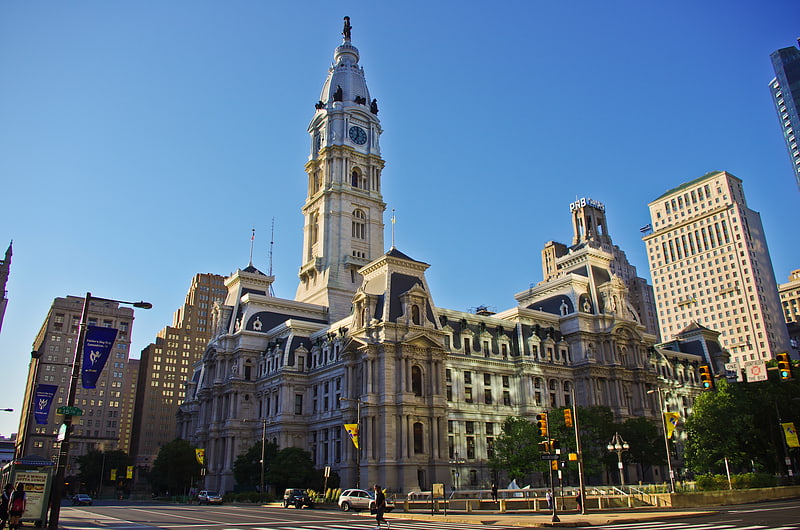
Massive, ornate government buidling. Philadelphia City Hall is the seat of the municipal government of the City of Philadelphia, Pennsylvania, housing the chambers of the Philadelphia City Council and the offices of the Mayor of Philadelphia. It is also a courthouse, serving as the seat of the First Judicial District of Pennsylvania, and houses the Civil Trial and Orphans' Court Divisions of the Court of Common Pleas of Philadelphia County.
Built of brick, white marble, and limestone, Philadelphia City Hall is the world's largest free-standing masonry building and was the world's tallest habitable building upon its completion in 1894. In 1976, it was designated a National Historic Landmark, and in 2006, also named a National Historic Civil Engineering Landmark by the American Society of Civil Engineers.[16]
Address: Broad St and Market St, 19107 Philadelphia (Center City)
Eastern State Penitentiary
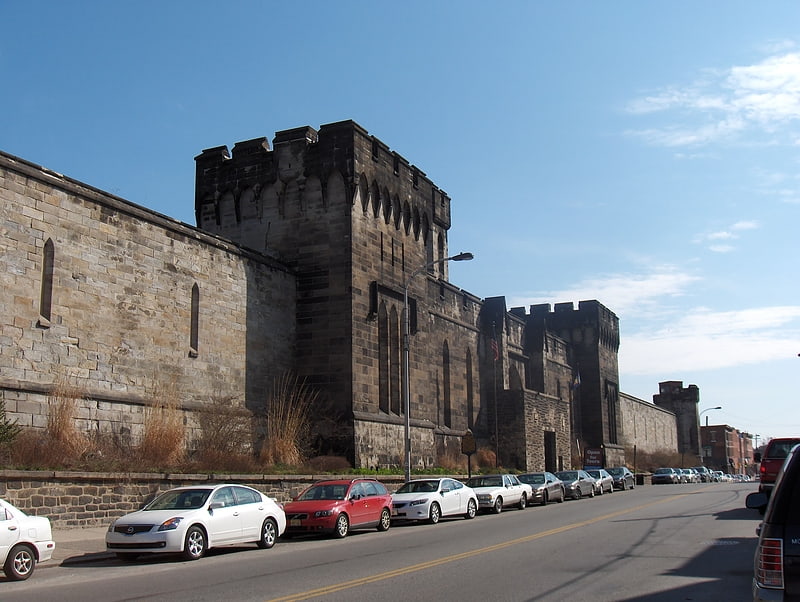
Historic prison with tours and exhibits. The Eastern State Penitentiary, also known as ESP, is a former American prison in Philadelphia, Pennsylvania. It is located at 2027 Fairmount Avenue between Corinthian Avenue and North 22nd Street in the Fairmount section of the city, and was operational from 1829 until 1971. The penitentiary refined the revolutionary system of separate incarceration first pioneered at the Walnut Street Jail which emphasized principles of reform rather than punishment.
Notorious criminals such as Al Capone and bank robber Willie Sutton were held inside its innovative wagon wheel design. James Bruno (Big Joe) and several male relatives were incarcerated here between 1936 and 1948 for the alleged murders in the Kelayres massacre of 1934, before they were paroled. At its completion, the building was the largest and most expensive public structure ever erected in the United States, and quickly became a model for more than 300 prisons worldwide.
The prison is currently a U.S. National Historic Landmark, which is open to the public as a museum for tours seven days a week, twelve months a year, 10 am to 5 pm.[17]
Address: 2027 Fairmount Ave, 19130 Philadelphia (Center City)
Independence National Historical Park
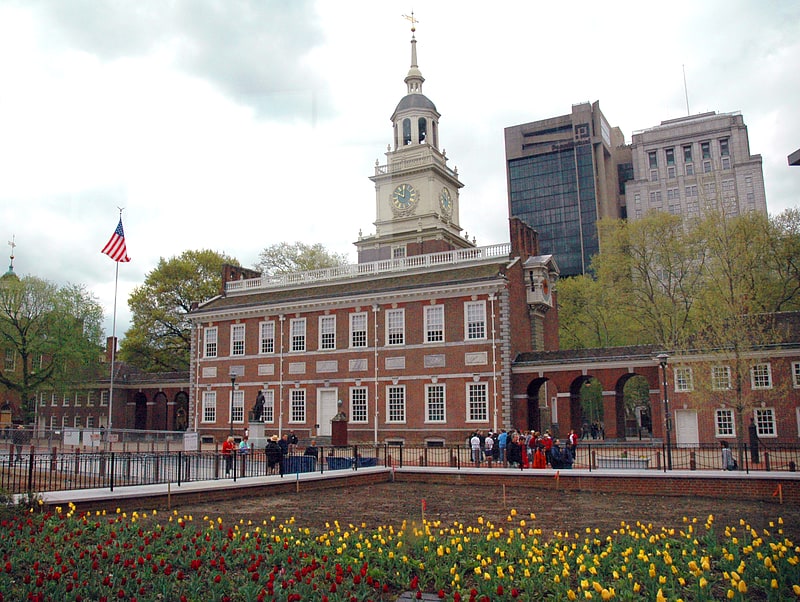
National shrine with the Liberty Bell. Independence National Historical Park is a federally protected historic district in Philadelphia, Pennsylvania, United States that preserves several sites associated with the American Revolution and the nation's founding history. Administered by the National Park Service, the 55-acre park comprises many of Philadelphia's most-visited historic sites within the Old City and Society Hill neighborhoods. The park has been nicknamed "America's most historic square mile" because of its abundance of historic landmarks.
The centerpiece of the park is Independence Hall, a UNESCO World Heritage Site, where the Declaration of Independence and the United States Constitution were debated and adopted by America's Founding Fathers in the late 18th century. Independence Hall was the principal meetinghouse of the Second Continental Congress from 1775 to 1783 and the Constitutional Convention in the summer of 1787.
Across the street from Independence Hall, the Liberty Bell, an iconic symbol of American independence, is displayed in the Liberty Bell Center. The park contains other historic buildings, such as the First Bank of the United States, the first bank chartered by the United States Congress, and the Second Bank of the United States, which had its charter renewal vetoed by President Andrew Jackson as part of the Bank War. Carpenters' Hall, the site of the First Continental Congress, is located on park property as well, however the building is privately owned and operated. It also contains City Tavern, a recreated colonial tavern, which was a favorite of the delegates and which John Adams felt was the finest tavern in all America.
Most of the park's historic structures are located in the vicinity of the four landscaped blocks between Chestnut, Walnut, 2nd, and 6th streets. The park also contains Franklin Court, the site of a museum dedicated to Benjamin Franklin and the United States Postal Service Museum. An additional three blocks directly north of Independence Hall, collectively known as Independence Mall, contain the Liberty Bell Center, National Constitution Center, Independence Visitor Center, and the former site of the President's House. The park also contains other historical artifacts, such as the Syng inkstand which was used during the signings of both the Declaration and the Constitution.[18]
Address: 143 S 3rd St, 19106-2818 Philadelphia (Center City)
Wells Fargo Center
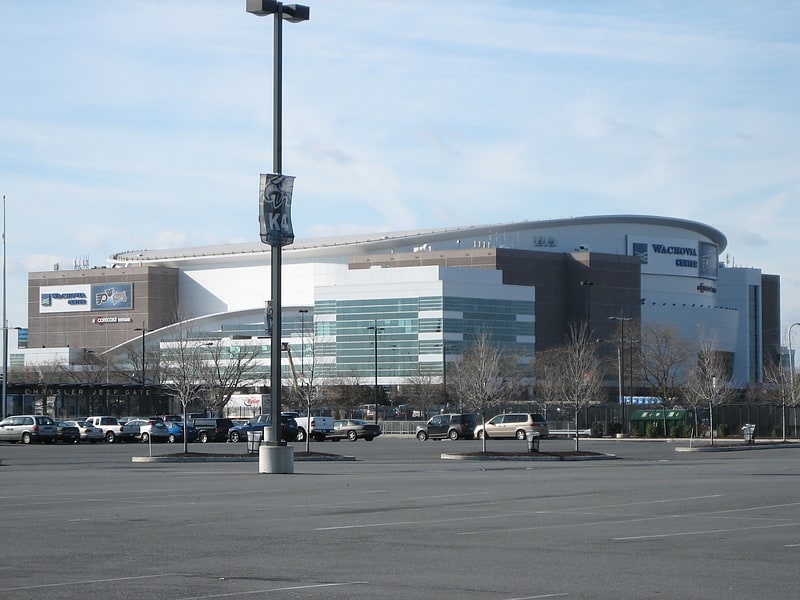
Arena in Philadelphia, Pennsylvania. The Wells Fargo Center is a multi-purpose arena located in Philadelphia. It serves as the home of the Philadelphia Flyers of the National Hockey League, the Philadelphia 76ers of the National Basketball Association, and the Philadelphia Wings of the National Lacrosse League. The arena lies at the southwest corner of the South Philadelphia Sports Complex, which includes Lincoln Financial Field, Citizens Bank Park, and Xfinity Live!.
The Wells Fargo Center, originally called Spectrum II, was completed in 1996 to replace the Spectrum as the home arena of the 76ers and Flyers, on the former site of John F. Kennedy Stadium at a cost of $210 million, largely privately financed (though the city and state helped to pay for the local infrastructure). It is owned by Comcast Spectacor, which also owns the Flyers, and is operated by its arena-management subsidiary, Global Spectrum. Since opening, it has been known by a number of different names through naming rights deals and bank mergers, including CoreStates Center from 1996 to 1998, First Union Center from 1998 to 2003, and Wachovia Center from 2003 to 2010. Since 2010, naming rights have been held by financial services company Wells Fargo, after their merger with Wachovia.
In addition to hosting home games for its main tenants, the arena has been the site of a number of other notable athletic events including Games 1 and 2 from the 1997 and Games 3, 4 and 6 of the 2010 Stanley Cup Finals, Games 3, 4 and 5 of the 2001 NBA Finals, and various collegiate events for the National Collegiate Athletic Association (NCAA). Wells Fargo Center has hosted two political conventions, hosting the 2000 Republican National Convention and 2016 Democratic National Convention. The arena is a regular venue for concerts and WWE events. The arena has a concert seating capacity of 21,000 seated and at least 21,500 standing.[19]
Address: Philadelphia, 3601 South Broad Street
Liberty Place
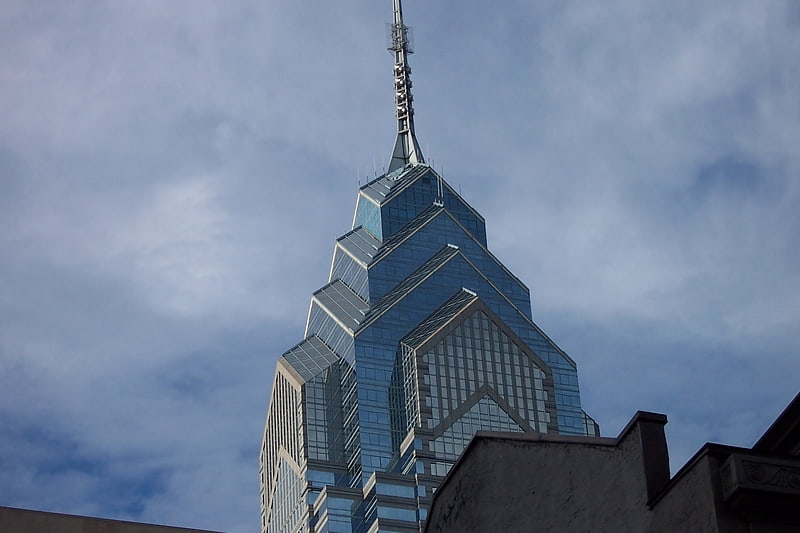
Shopping mall in Philadelphia, Pennsylvania. Liberty Place is a skyscraper complex in Philadelphia, Pennsylvania, United States. The complex is composed of a 61-story, 945-foot skyscraper called One Liberty Place, a 58-story, 848-foot skyscraper called Two Liberty Place, a two-story shopping mall called the Shops at Liberty Place, and the 14-story Westin Philadelphia Hotel. Prior to the construction of Liberty Place, there was a gentlemen's agreement not to build any structure in Center City higher than the statue of William Penn on top of Philadelphia City Hall. The tradition lasted until 1984 when developer Willard G. Rouse III of Rouse & Associates announced plans to build an office building complex that included two towers taller than City Hall. There was a great amount of opposition to the construction of the towers with critics believing breaking the height limit would lead to construction of many more tall skyscrapers, ruining the livability and charm of Center City. Despite the opposition, construction of One Liberty Place was approved and the first phase of the project began in 1985 and was completed in 1987. One Liberty Place became the city's first skyscraper.
Phase 2 of the project included Two Liberty Place, a hotel, a shopping mall, and a parking garage. Construction began 1988, after Cigna agreed to lease the entirety of the skyscraper for use as that company's world headquarters. Construction was completed in 1990, making Two Liberty Place the second-tallest building in the city. The two towers held their place as first- and second-tallest buildings in Philadelphia until the Comcast Center was topped off in 2007, which was topped off in 2017 by the Comcast Technology Center. Liberty Place was received enthusiastically by critics and led to the construction of other tall skyscrapers giving Philadelphia what architecture critic Paul Goldberger called "one of the most appealing skylines of any major American city".
Liberty Place was designed by architect Helmut Jahn and his firm Murphy/Jahn. The steel and blue glass skyscrapers were heavily influenced by New York City's Chrysler Building. The major influence is the spire made of gabled angular setbacks. Two Liberty Place's spire is shorter and squatter, a design influenced by the needs of tenant Cigna. In the 2000s, Cigna reduced its presence in the tower, which led to the owners converting the upper floors into 122 luxury condominiums. Below the two towers is the 289 room Westin hotel and the 143,000 square feet (13,000 m2) Shops at Liberty Place. The main feature of the mall is a round atrium topped by a large glass dome.[20]
Address: 1625 Chestnut St, 19103 Philadelphia (Center City)
Museum of the American Revolution
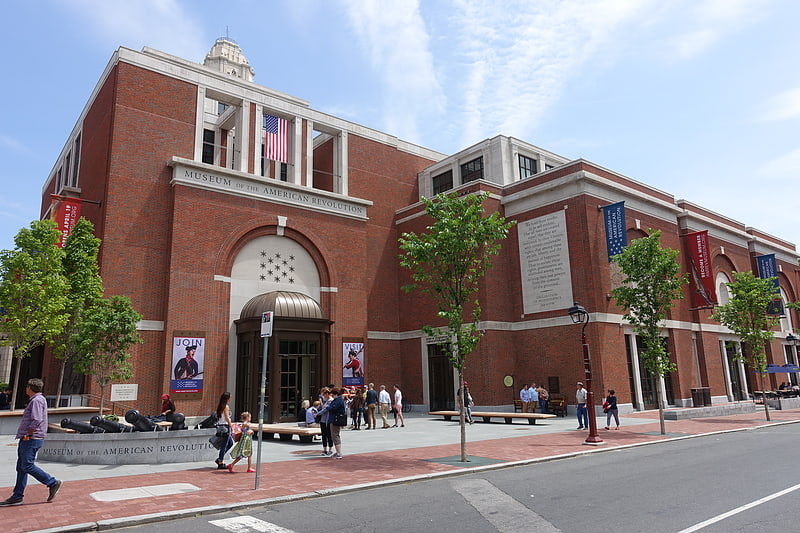
Museum in Philadelphia, Pennsylvania. The Museum of the American Revolution is a museum in Philadelphia, Pennsylvania, dedicated to telling the story of the American Revolution. The museum was opened to the public on April 19, 2017, the 242nd anniversary of the first battles of the war, at Lexington and Concord, on April 19, 1775.[21]
Address: 101 S 3rd St, 19106 Philadelphia (Center City)
Franklin Institute
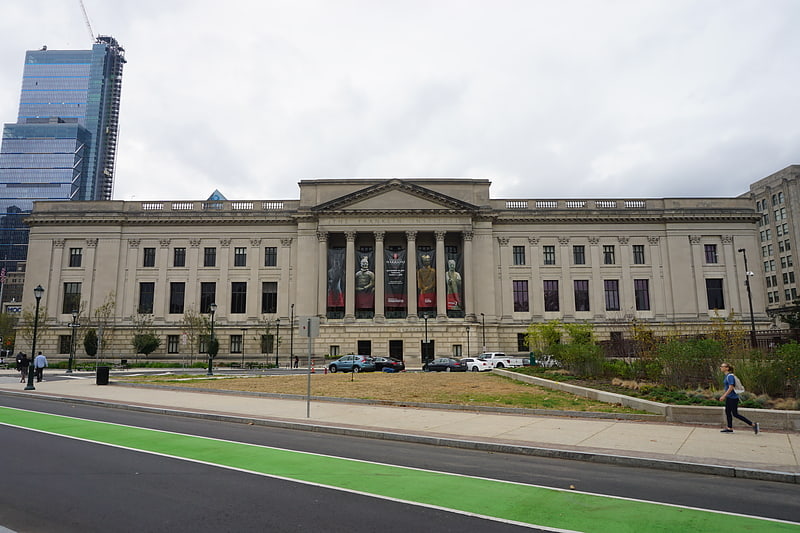
Kid-friendly, interactive science museum. The Franklin Institute is a science museum and the center of science education and research in Philadelphia, Pennsylvania. It is named after the American scientist and statesman Benjamin Franklin, and houses the Benjamin Franklin National Memorial. Founded in 1824, the Franklin Institute is one of the oldest centers of science education and development in the United States.[22]
Address: 222 N 20th St, 19103 Philadelphia (Center City)
Logan Circle
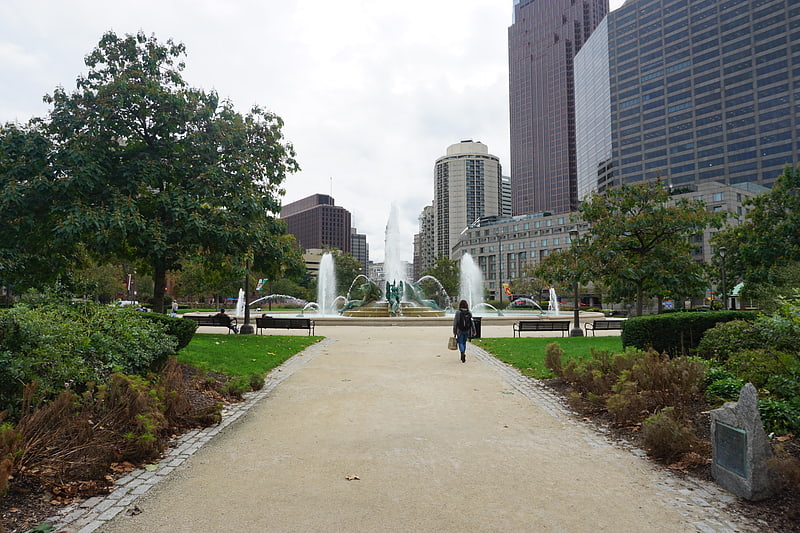
Park in Philadelphia, Pennsylvania. Logan Circle, also known as Logan Square, is an open-space park in Center City Philadelphia's northwest quadrant and one of the five original planned squares laid out on the city grid. The centerpiece of the park is the Logan Circle, a circular area centered on a large water feature, bounded by a traffic circle carrying 19th Street and the Benjamin Franklin Parkway. The circle exists within the original bounds of the square; the names Logan Square and Logan Circle are used interchangeably when referring to the park. Originally "Northwest Square" in William Penn's 1684 plan for the city, the square was renamed in 1825 after Philadelphia statesman James Logan. The park is the focal point of the eponymous neighborhood. Logan Square was added to the National Register of Historic Places in 1981.[23]
Address: Benjamin Franklin Parkway at 19th Street, 19103 Philadelphia (Center City)
Penn Museum
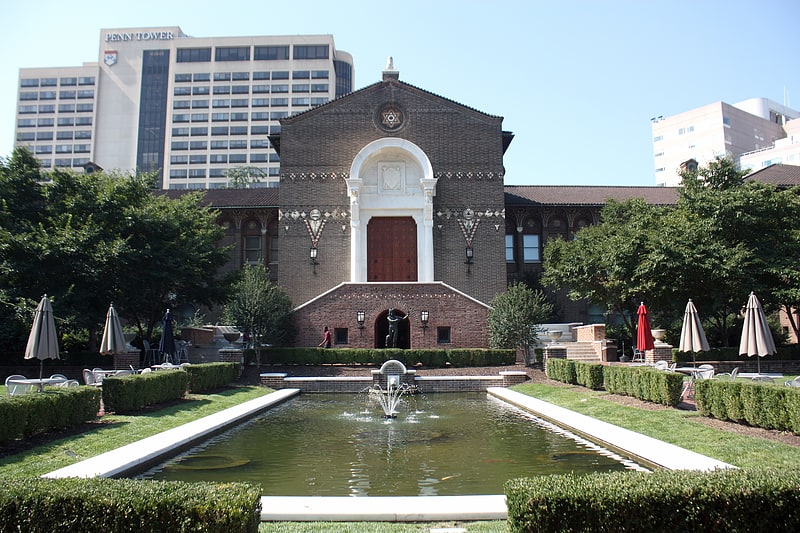
Museum of archaeology and anthropology. The University of Pennsylvania Museum of Archaeology and Anthropology—commonly known as the Penn Museum—is an archaeology and anthropology museum associated with the University of Pennsylvania. It is located on Penn's campus in the University City neighborhood of Philadelphia, at the intersection of 33rd and South Streets. Housing over 1.3 million artifacts, the museum features one of the most comprehensive collections of middle and near-eastern art in the world.[24]
Address: 3260 South St, 19104 Philadelphia (West Philadelphia)
Dilworth Park

Park in Philadelphia, Pennsylvania. Dilworth Park is a public park and open space along the western side of City Hall in Center City, Philadelphia. The one-half-acre park opened to the public on September 4, 2014.[25]
Address: 1 South 15th Street, Philadelphia (Center City)
The Center for Art in Wood

Art institute in Philadelphia, Pennsylvania. The Center for Art in Wood is an American educational wood art institution located in Philadelphia, Pennsylvania. It was officially established as a nonprofit in 1986 by brothers Albert and Alan LeCoff, following a series of international symposium from 1976-1986 presented by the LeCoff's with woodturner Palmer Sharpless. The organization operated as the Wood Turning Center until 2011, when the nonprofit moved to its current location in Old City District of Philadelphia and changed its name to The Center for Art in Wood.
Today, the Center presents changing exhibitions of contemporary art work in the medium of wood, a permanent collection of over 1,000 pieces and a host of educational programs and workshops. The Center also houses a research library, artists files, and a museum store. A series of publications documents the Center's work and highlights premier artists working in the field of wood turning and art in wood.[26]
Address: 141 N 3rd St, 19106-1913 Philadelphia (Center City)
Academy of Natural Sciences of Drexel University
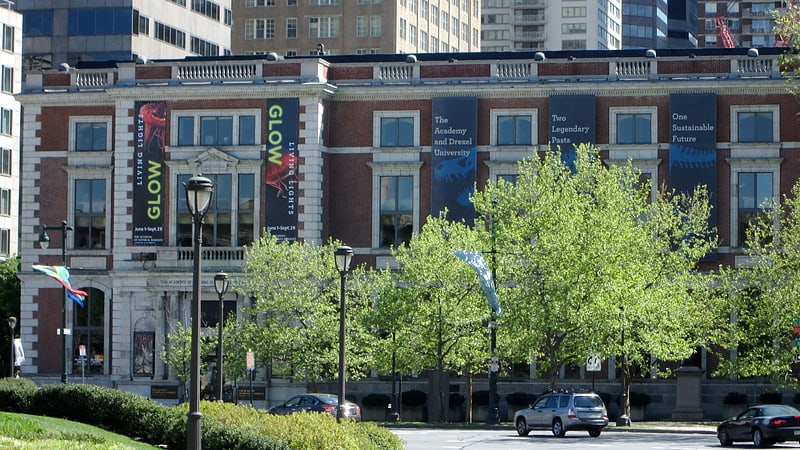
Family-friendly natural history museum. The Academy of Natural Sciences of Drexel University, formerly the Academy of Natural Sciences of Philadelphia, is the oldest natural science research institution and museum in the Americas. It was founded in 1812, by many of the leading naturalists of the young American republic with an expressed mission of "the encouragement and cultivation of the sciences". For over two centuries of continuous operations, the Academy has sponsored expeditions, conducted original environmental and systematics research, and amassed natural history collections containing more than 17 million specimens. The Academy also has a long tradition of public exhibits and educational programs for both schools and the general public.[27]
Address: 1900 Benjamin Franklin Pkwy, 19103-1101 Philadelphia (Center City)
Love Park
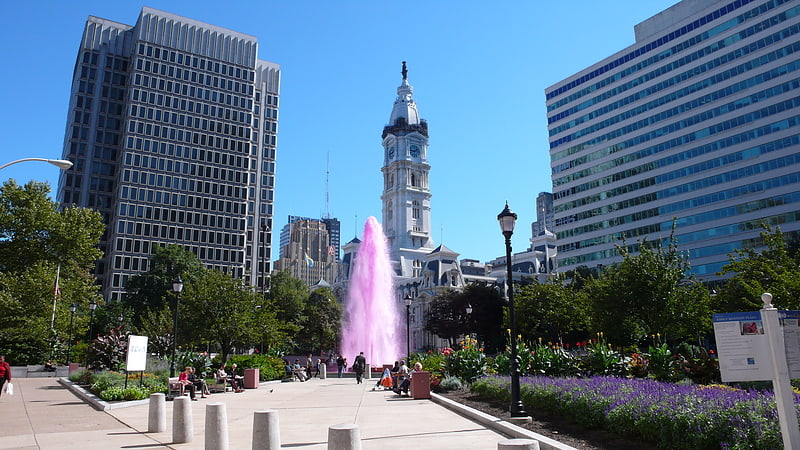
Park in Philadelphia, Pennsylvania. LOVE Park, officially known as John F. Kennedy Plaza, is a public park located in Center City, Philadelphia, Pennsylvania. The park is nicknamed LOVE Park for its reproduction of Robert Indiana's 1970 LOVE sculpture which overlooks the plaza.
The area has a following in the skate world due to its prominence in the early 2000s cult classic video game Tony Hawk's Pro Skater 2.[28]
Address: John F. Kennedy Blvd and North 15th St, 19102 Philadelphia (Center City)
Masonic Temple

Museum in Philadelphia, Pennsylvania. The Masonic Temple is a historic Masonic building in Philadelphia. Located at 1 North Broad Street, directly across from Philadelphia City Hall, it serves as the headquarters of the Grand Lodge of Pennsylvania, Free and Accepted Masons. The Temple features the Masonic Library and Museum of Pennsylvania, and receives thousands of visitors every year to view the ornate structure, which includes seven lodge rooms, where today a number of Philadelphia lodges and the Grand Lodge conduct their meetings.
The Temple was designed in the medieval Norman style by James H. Windrim, who was 27 years old at the time he won the design competition. The massive granite cornerstone, weighing ten tons, was leveled on St. John the Baptist's Day, June 24, 1868. The ceremonial gavel used on that day by Grand Master Richard Vaux was the same gavel used by President George Washington in leveling the cornerstone of the nation's Capitol building in 1793.
The construction was completed five years later, in 1873. The interior, designed by George Herzog, was begun in 1887 and took another fifteen years to finish.
The bold and elaborate elevations on Broad and Filbert Streets, especially the beautiful portico of Quincy granite, make it one of the great architectural wonders of Philadelphia. The exterior stone of the building on Broad and Filbert Streets is Cape Ann Syenite from Syne in Upper Egypt.
On May 27, 1971, the Temple was listed on the National Register of Historic Places. It was designated a National Historic Landmark in 1985. It was cited in its landmark designation as one of the nation's most elaborate examples of Masonic architecture.[29]
Address: 1 N Broad St, 19107 Philadelphia (Center City)
Comcast Center
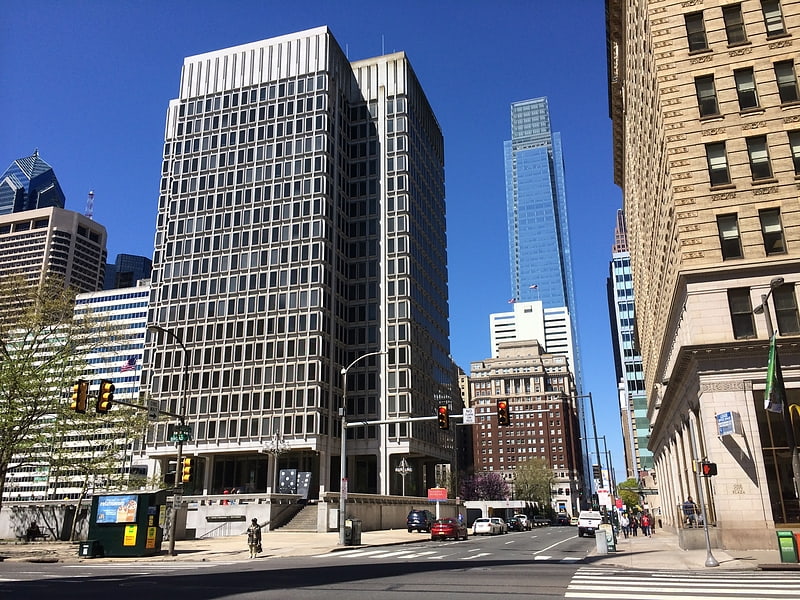
Skyscraper in Philadelphia, Pennsylvania. Comcast Center, also known as the Comcast Tower, is a skyscraper in Center City, Philadelphia, Pennsylvania, United States. The 58-story, 297-meter tower is the second-tallest building in Philadelphia and the state of Pennsylvania, as well as the twenty-third tallest building in the United States. Originally called One Pennsylvania Plaza when the building was first announced in 2001, the Comcast Center went through two redesigns before construction began in 2005. Comcast Center was designed by Robert A.M. Stern Architects for Liberty Property Trust.
At the beginning of 2005, the final redesign and its new name—the Comcast Center—was unveiled. The building is named after its lead tenant, cable company Comcast, which makes the skyscraper its corporate headquarters. Leasing 1,094,212 square feet (101,656 m2), Comcast takes up 89 percent of the building. The building features retail and restaurant space and a connection to the nearby Suburban Station. In Comcast Center's lobby is the Comcast Experience, which is a 2,000-square-foot (190 m2) high-definition LED screen that has become a tourist attraction. Designed to be environmentally friendly, the skyscraper is the tallest Leadership in Energy and Environmental Design (LEED) certified building in Philadelphia.[30]
Address: 1701 John F Kennedy Blvd #300, 19103 Philadelphia (Center City)
Fort Mifflin
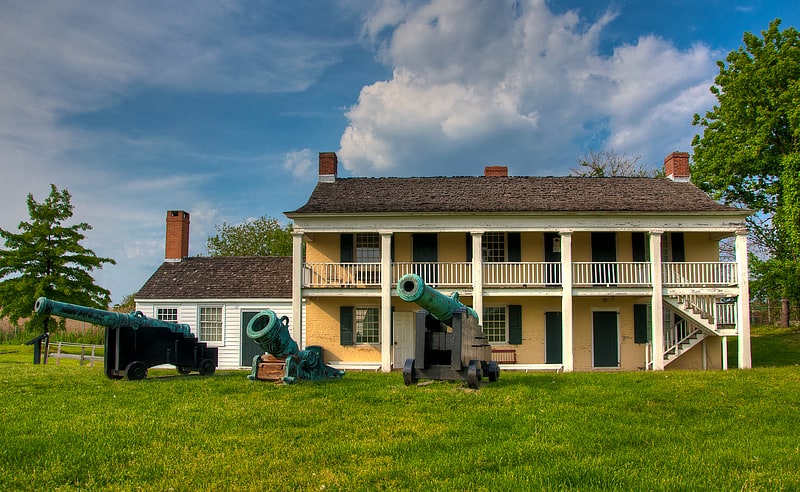
Historical place in Philadelphia, Pennsylvania. Fort Mifflin, originally called Fort Island Battery and also known as Mud Island Fort, was commissioned in 1771 and sits on Mud Island on the Delaware River below Philadelphia, Pennsylvania near Philadelphia International Airport. During the American Revolutionary War, the British Army bombarded and captured the fort as part of their conquest of Philadelphia in autumn 1777. In 1795 the fort was renamed for Thomas Mifflin, a Continental Army officer and the first post-independence Governor of Pennsylvania. The United States Army began to rebuild the fort in 1794 and continued to garrison and build on the site through the 19th century. It housed prisoners during the American Civil War. The army decommissioned Fort Mifflin for active duty infantry and artillery in 1962. However, while the older portion of the fort was returned to the City of Philadelphia, a portion of the fort's grounds are still actively used by the United States Army Corps of Engineers, making it the oldest fort in military use in the United States. Historic preservationists have restored the fort, which is now a National Historic Landmark.[31]
Address: 1 Fort Mifflin Rd, 19153 Philadelphia
Kimmel Center for the Performing Arts
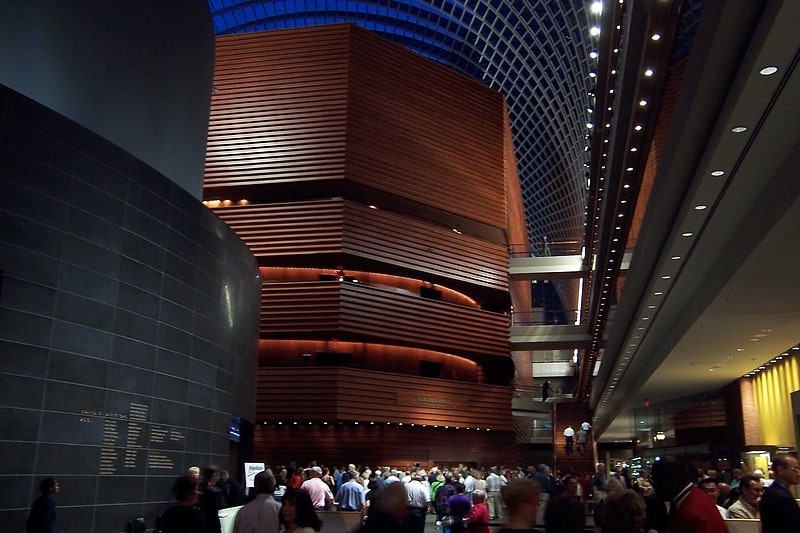
Theater in Philadelphia, Pennsylvania. The Kimmel Center for the Performing Arts is a large performing arts venue at 300 South Broad Street and the corner of Spruce Street, along the stretch known as the "Avenue of the Arts", in Center City, Philadelphia, Pennsylvania. It is owned and operated by Kimmel Cultural Center, which also manages the Academy of Music in Philadelphia, and, as of November 2016, the Merriam Theater. The center is named after philanthropist Sidney Kimmel.
The Center is the home of the Philadelphia Orchestra, one of America's "Big Five" symphony orchestras. It is also the home venue of the Philadelphia Youth Orchestra, Chamber Orchestra of Philadelphia, Philadanco, the Philadelphia Chamber Music Society, and the Kimmel Center Presents performance series, which features a variety of jazz, classical, and world pop performers.[32]
Address: Philadelphia, 300 South Broad Street
American Philosophical Society
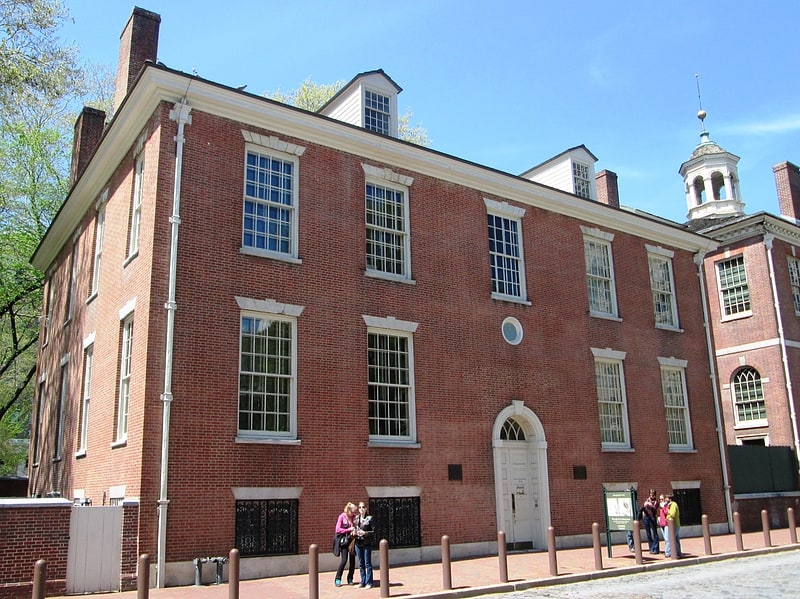
The American Philosophical Society, founded in 1743 in Philadelphia, is a scholarly organization that promotes knowledge in the sciences and humanities through research, professional meetings, publications, library resources, and community outreach. Considered the first learned society in the United States, it has about 1,000 elected members, and by April 2020 had had only 5,710 members since its creation. Through research grants, published journals, the American Philosophical Society Museum, an extensive library, and regular meetings, the society supports a variety of disciplines in the humanities and the sciences.
Philosophical Hall, now a museum, is just east of Independence Hall in Independence National Historical Park; it was designated a National Historic Landmark in 1965.[33]
Address: 104 S 5th St, 19106-3387 Philadelphia (Center City)
Carpenters' Hall
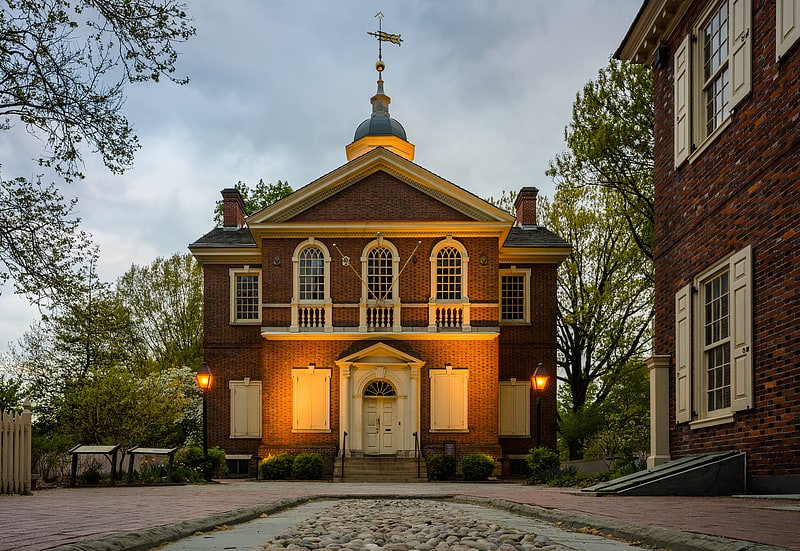
Historic, Georgian-style meeting house. Carpenters' Hall is the official birthplace of the Commonwealth of Pennsylvania and a key meeting place in the early history of the United States. It is in Independence National Historical Park in Philadelphia, Pennsylvania.
Completed in 1775, the two-story brick meeting hall was built for and still privately owned by the Carpenters' Company of the City and County of Philadelphia, the country's oldest extant craft guild. The First Continental Congress met here in 1774 and it was the location of the Pennsylvania Provincial Conference in June 1776. Their proceedings officially declared the Province of Pennsylvania's independence from the British Empire and established the Commonwealth of Pennsylvania, mobilized the Pennsylvania militia for the American Revolutionary War, set up the machinery for the Pennsylvania Provincial Convention (July 15 – September 28, 1776) which framed the Pennsylvania Constitution of 1776, and enabled the United States Declaration of Independence to proceed. It was briefly occupied in 1777 by the British Army during the war.
The site was designated a National Historic Landmark on April 15, 1970. On November 30, 1982, the Pennsylvania Historical and Museum Commission succeeded in passing Pennsylvania General Assembly 166(R) HR180 to recognize "Carpenters' Hall as the official birthplace of the Commonwealth of Pennsylvania".[34]
Address: 320 Chestnut St, 19106-2708 Philadelphia (Center City)
Merchants' Exchange Building

The Merchants' Exchange Building is a historic building located on the triangular site bounded by Dock Street, Third Street, and Walnut Street in the Old City neighborhood of Philadelphia, Pennsylvania. It was designed by architect William Strickland, in the Greek Revival style, the first national American architectural style and built between 1832 and 1834. It operated as a brokerage house in the nineteenth century, but by 1875 the Philadelphia Stock Exchange had taken the place of the Merchants' Exchange.
The building was declared a National Historic Landmark in 2001. It is the oldest existing stock exchange building in the United States, but is now used as the headquarters of the Independence National Historical Park.[35]
Address: 143 South 3rd Street, Philadelphia (Center City)